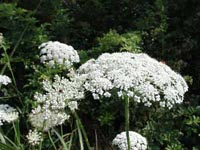Resource Library
Plant of the Week: Queen Anne's Lace
The University of Arkansas System Division of Agriculture does not promote, support or recommend plants featured in "Plant of the Week." Please consult your local Extension office for plants suitable for your region.
Plant of the Week
Queen Anne's Lace
Latin: Daucus carota

Queen Anne's Lace is one of our most common roadside wildflowers or weeds, depending on your perspective. I admire the delicate, lacy character of the white flower in early summer, but to me it's a weed. Not everyone agrees.
Queen Anne's Lace (Daucus carota), a member of the parsnip family, is the wild progenitor of the cultivated carrot. It's native across much of southern Europe and central Asia but has spread throughout all regions of the United States and Canada. It's most at home along roadways that are periodically mown to keep down really tall vegetation, but it's never a serious lawn weed because it can't tolerate close mowing.
In our climate, Queen Anne's lace behaves as a winter annual with seeds germinating in the fall. The slender, white, branched taproots forms lacy leaves reminiscent of the cultivated carrot. Though the taproot is as woody as a tree limb, it gives off the distinctive carrot smell when crushed. The summer plants send up 3 feet tall, branched, hairy stems bearing flowers and lacy leaves.
The terminal flower cluster (an umbel) is the largest and may reach 4 to 5 inches across. Side branches form freely, but the umbels are usually half as large.
The umbels are made up of hundreds of tiny white blossoms, except for one central floret that's a deep purple. Speculation has it that this tiny purple floret in the lacelike array of white flowers may have been an example of floral mimickery. It probably looked like the alluring end of a female bug, inviting amorous males in for a visit, only to do pollination work instead.
When the seeds mature, the umbel curls inward and forms a nest-like collection of bristle-armed seeds that cause them to stick easily to passing pets or pant legs. As the seeds begin ripening, the plant dies.
The widespread occurrence of Queen Anne's lace is probably due to reversion of the cultivated type to wild forms. The first cultivated carrots were from Afghanistan, but they were either white or purple. The purple color came from anthocyanin pigments, the same pigment found in beets.
The stubby, yellow and then orange anthocyanin-free carrots we know today appeared as mutants in the 16th century. Apparently, there was not an organized environmental movement at the time, because the frankenfood label didn't appear until genetically engineered crops arrived in the 1990s.
A French seedman, Henri Vilmorin, demonstrated in the 1840s that in three simple crosses using wild plants it was possible recreate the carrot grown in the garden. So, it seems likely that the reverse happened when a few cultivated plants were allowed to go to seed without supervision. Reversion occurred, and Queen Anne's lace filled the waste places of the world. Carrot breeders must carefully inspect all of their seed production fields, because the presence of a single wild plant can ruin an entire seed field.
Everything that's old, at some point is new again.
Dr. Leonard Pike, a south Arkansas boy who's a vegetable breeder for Texas A&M University, recently released what he calls "Beta Sweet" carrots that again contain anthocyanin. His plants are classified as maroon, but they look purple to me.
Anthocyanin acts as an antioxidant, so possibly these new carrots will have a place in planning a healthy lifestyle. But, you'll probably find them only in candle-lit restaurants, because who could eat purple carrots?
By: Gerald Klingaman, retired
Extension Horticulturist - Ornamentals
Extension News - July 22, 2005
The University of Arkansas System Division of Agriculture does not maintain lists of retail outlets where these plants can be purchased. Please check your local nursery or other retail outlets to ask about the availability of these plants for your growing area.